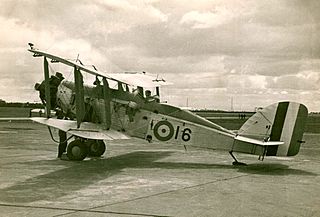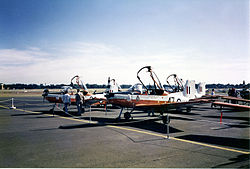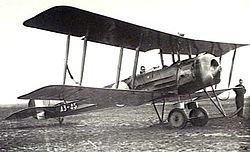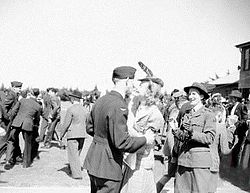- No. 1 Flying Training School RAAF
-
No. 1 Flying Training School 
A cadet prepares for a solo training flight in a Westland Wapiti at No. 1 FTS, Point Cook, 1938Active 1921–1944
1947–1993Allegiance  Australia
AustraliaBranch  Royal Australian Air Force
Royal Australian Air ForceRole Flying training Garrison/HQ RAAF Point Cook
(1921–44, 1947–58, 1969–93)
RAAF Base Pearce (1958–69)Motto Cogito Ergo Sum [1] Commanders Notable
commandersFrank McNamara
(1922–25, 1930–33)
William Anderson (1925–26)
Adrian Cole (1926–29)
Hippolyte De La Rue (1933–37)
Frank Lukis (1938–39)
John McCauley (1940–41)
Charles Read (1943–44, 1947–49)No. 1 Flying Training School (No. 1 FTS) was a flying training school of the Royal Australian Air Force (RAAF). It was one of the Air Force's original units, dating back to the service's formation in 1921, when it was based at RAAF Point Cook, Victoria. The school underwent a number of reorganisations during its existence. In 1940 it was re-formed as No. 1 Service Flying Training School under the wartime Empire Air Training Scheme, disbanding in 1944. After World War II, it was re-established at Point Cook, as No. 1 FTS. It re-formed again in 1952 as No. 1 Applied Flying Training School (No. 1 AFTS), and was transferred to RAAF Base Pearce, Western Australia, in 1958. Meanwhile, in 1951, No. 1 Basic Flying Training School (No. 1 BFTS) had been formed at Uranquinty, New South Wales, moving to Point Cook in 1958. In 1969, No. 1 AFTS re-formed as No. 2 Flying Training School and No. 1 BFTS re-formed as No. 1 FTS. No. 1 FTS was finally disbanded at Point Cook in 1993.
Contents
History
Early years
No. 1 Flying Training School (No. 1 FTS) was the first unit to be formally established as part of the new Australian Air Force on 31 March 1921 (the prefix "Royal" was added in August that year). No. 1 FTS was formed from the remnants of Australia's original military flying unit, Central Flying School, at RAAF Point Cook, Victoria.[2][3] Squadron Leader William Anderson, who was in charge of Point Cook, was effectively No. 1 FTS's first commanding officer.[2][4] Its initial complement of aircraft included twelve Avro 504Ks, six Airco DH.9s, three Royal Aircraft Factory S.E.5s, and three Sopwith Pups.[5] Flight Lieutenant Frank McNamara VC took command of the school in 1922.[6] The inaugural flying course commenced in January 1923, with basic instruction taking place on the 504K, and advanced training on the other types.[7][8] Squadron Leader Anderson formally took command of No. 1 FTS in 1925; the following year he handed over to Wing Commander Adrian Cole, who led the unit until 1929.[4][9] The first Citizen Air Force (reserve) pilots' course took place in 1926; although 24 accidents occurred, there were no fatalities, leading Cole to remark at the graduation ceremony that the students were either made of India rubber or had learned how to crash "moderately safely".[10][11] However, the Permanent Air Force cadet course that year was marred by three fatal accidents.[12]
Squadron Leader McNamara again assumed command of the school in 1930. By this time, it had been reorganised into three components: Training Squadron, operating Westland Wapitis; Fighter Squadron, operating Bristol Bulldogs; and Seaplane Squadron, operating Supermarine Southamptons. The latter pair were, however, "really little more than flights"; Fighter Squadron was dissolved in 1935 when its Bulldogs were transferred to No. 1 Squadron at RAAF Laverton, while Seaplane Squadron was extant until 1939, when it was separated to form the basis of No. 10 Squadron.[1][13] One of the school's leading instructors at this time was Flight Lieutenant Frederick Scherger, who was also a flight commander in Fighter Squadron.[14] In 1932, No. 1 FTS began running two courses each year, the first commencing in January and the second in July.[15] Wing Commander Hippolyte De La Rue became commanding officer in 1933.[16] The Wapitis were augmented by Avro Cadet trainers in 1936.[1] By the time De La Rue handed over to Wing Commander Frank Lukis in 1938,[17] the school was training a maximum of 96 new pilots per year, a small number of whom were slated for secondment to the Royal Air Force.[18] Link Trainer simulators were introduced in March 1939.[1]
World War II
RAAF flying training was heavily reorganised soon after the outbreak of World War II, in response to Australia's participation in the Empire Air Training Scheme. A number of Elementary Flying Training Schools were formed, to provide basic flight instruction to cadets, while more advanced instruction was to take place at Service Flying Training Schools.[19][20] During April–May 1940, No. 1 FTS was re-formed at Point Cook as No. 1 Service Flying Training School (No. 1 SFTS),[21] while its Instructors' Training Squadron formed the nucleus of a re-formed Central Flying School, which relocated to Camden, New South Wales, in June.[20] The courses at the Service Flying Training Schools consisted of two streams, intermediate and advanced; the total duration varied during the war as demand for aircrew rose and fell. Initially running for 16 weeks, the course was cut to 10 weeks (which included 75 hours flying time) in October 1940. A year later it was raised to 12 weeks (including 100 hours flying time), and again to 16 weeks two months later. It continued to increase after this, peaking at 28 weeks in June 1944.[22]
The initial complement of 52 aircraft at No. 1 SFTS included Wapitis, Cadets, Avro Ansons, Hawker Demons, and a De Havilland Tiger Moth. Group Captain John McCauley served as commanding officer from October 1940 until July 1941, when he handed over to Wing Commander Evelyn King, who went on to take charge of Station Headquarters Point Cook in October.[21][23] By this stage, No. 1 SFTS had an establishment of 100 officers and over 2,000 airmen, operating more than 100 aircraft and training up to 300 cadets at any one time. The aircraft types now included De Havilland Gypsy Moths and DH.89 Dragon Rapides, Douglas C-47 Dakotas, CAC Wirraways and Airspeed Oxfords, the latter two being the mainstays. Wing Commander Charles Read held command of the school from October 1943 until its disbandment in September 1944, by which time almost 3,000 pilots had graduated from the school.[21] Among these were Nicky Barr, who became one of Australia's leading fighter aces, and Bill Newton, awarded the Victoria Cross for bombing raids in New Guinea during 1943.[24][25]
Post-war years
In February 1946, the personnel and equipment of No. 5 Service Flying Training School, which had been reduced after the war to a care-and-maintenance unit at its base in Uranquinty, New South Wales, were used to re-establish No. 1 FTS.[26] Its aircraft included one Anson, two Tiger Moths, and 55 Wirraways. By August 1947, the school had been transferred to Point Cook, where it was led by Wing Commander Read. Its No. 1 Aircrew Course commenced in February 1948, graduating in August the following year, after which Read handed over to Squadron Leader Glen Cooper.[1][27] In response to demands for more aircrew to fulfill Australia's commitments to the Korean War and Malayan Emergency, flying training in the RAAF underwent major changes in 1951–52, with the syllabus at No. 1 FTS being split among three separately located units.[28] No. 1 Initial Flying Training School (No. 1 IFTS) was raised at Archerfield, Queensland, to impart students with general aeronautical and military knowledge, after which they received their flight grading during twelve hours on Tiger Moths. Graduate pilots of No. 1 IFTS went on to the newly formed No. 1 Basic Flying Training School (No. 1 BFTS) at Uranquinty, where they underwent a further 90 hours of aerial instruction that included instrument, formation and night flying, first on Tiger Moths and then on Wirraways. Successful students finally transferred to No. 1 FTS, which was renamed No. 1 Applied Flying Training School (No. 1 AFTS) in March 1952. There they undertook 100 flying hours of advanced weapons and combat training on Wirraways, before graduating as Sergeant Pilots.[29] The Tiger Moths and Wirraways were later replaced by the locally designed CAC Winjeel, first delivered in 1955.[30]
 CT-4 trainers lined up for auction at Bankstown Airport, following the closure of No. 1 FTS in 1993
CT-4 trainers lined up for auction at Bankstown Airport, following the closure of No. 1 FTS in 1993
In May 1958, No. 1 AFTS relocated to RAAF Base Pearce, Western Australia, where it re-equipped with De Havilland Vampire jet trainers. Its place at Point Cook was taken by No. 1 BFTS, which transferred from Uranquinty.[1][29] The Vampires of No. 1 AFTS were replaced by Macchi MB-326Hs commencing in 1968.[31] The introduction of the Macchi led to a brief flirtation with "all-through" jet training in the Air Force, which was dropped after two courses as being "an expensive way of finding out that some pupils lacked the aptitude to become military pilots".[29] On 31 December 1968, No. 1 AFTS was disbanded at Pearce, re-forming there as No. 2 Flying Training School on 1 January 1969. At the same time, No. 1 BFTS was disbanded at Point Cook and re-formed as No. 1 FTS.[1] In late 1975, the Winjeels of No. 1 FTS were replaced by CT-4 Airtrainers.[30][32] On 1 May 1988, the CT-4s took part in one of the RAAF's largest flypasts, when 24 of the trainers formed the number "88" in the sky above Point Cook. In November 1989, one of the school's CT-4s recreated the first trans-Australia flight that had taken place 70 years before, when Captain Henry Wrigley and Sergeant Arthur Murphy flew a Royal Aircraft Factory B.E.2 biplane from Point Cook to Darwin, Northern Territory, in 1919.[32][33] Rationalisation of RAAF flying training saw the retirement of the CT-4s in late 1992, followed by disbandment of No. 1 FTS on 31 January 1993.[1][29][32] Since this date initial flight grading and basic flying training has been conducted by civilian contractors at the Australian Defence Force Basic Flying Training School.[32]
Notes
- ^ a b c d e f g h RAAF Historical Section, Units of the Royal Australian Air Force, pp. 38–39
- ^ a b Coulthard-Clark, The Third Brother, p. 41
- ^ Stephens, The Royal Australian Air Force, p. 29
- ^ a b Anderson, William Hopton at Australian Dictionary of Biography. Retrieved on 12 February 2011.
- ^ Coulthard-Clark, The Third Brother, p. 33
- ^ McNamara, Frank Hubert (Francis) at Australian Dictionary of Biography. Retrieved on 12 February 2011.
- ^ Gillison, Royal Australian Air Force 1939–1942, pp. 23–24
- ^ Stephens, The Royal Australian Air Force, p. 34
- ^ Cole, Adrian Lindley Trevor at Australian Dictionary of Biography. Retrieved on 12 February 2011.
- ^ Stephens, The Royal Australian Air Force, p. 37
- ^ Coulthard-Clark, The Third Brother, p. 238
- ^ Coulthard-Clark, The Third Brother, p. 207
- ^ Coulthard-Clark, The Third Brother, pp. 186–187, 127–128
- ^ Coulthard-Clark, The Third Brother, pp. 188–189, 202–203
- ^ Coulthard-Clark, The Third Brother, p. 201
- ^ De La Rue, Hippolyte Ferdinand at Australian Dictionary of Biography. Retrieved on 12 February 2011.
- ^ Lukis, Francis William Fellowes at Australian Dictionary of Biography. Retrieved on 12 February 2011.
- ^ Gillison, Royal Australian Air Force 1939–1942, p. 44
- ^ Gillison, Royal Australian Air Force 1939–1942, pp. 72–73
- ^ a b Gillison, Royal Australian Air Force 1939–1942, p. 97
- ^ a b c RAAF Historical Section, Units of the Royal Australian Air Force, pp. 100–101
- ^ Gillison, Royal Australian Air Force 1939–1942, p. 109
- ^ King, Elwyn Roy at Australian Dictionary of Biography. Retrieved on 16 February 2011.
- ^ Wing Commander Andrew William Barr at Australian War Memorial. Retrieved on 16 February 2011.
- ^ Weate, Bill Newton VC, pp. 19–22
- ^ RAAF Historical Section, Units of the Royal Australian Air Force, pp. 107–108
- ^ Stephens, Going Solo, pp. 145–146
- ^ Stephens, Going Solo, p. 149
- ^ a b c d Stephens, The Royal Australian Air Force, pp. 199–200
- ^ a b Winjeel at RAAF Museum. Retrieved on 12 February 2011.
- ^ DHA Vampire at RAAF Museum. Retrieved on 12 February 2011.
- ^ a b c d CT-4A Airtrainer at RAAF Museum. Retrieved on 12 February 2011.
- ^ Stephens, The Royal Australian Air Force, p. 26
References
- Coulthard-Clark, Chris (1991). The Third Brother: The Royal Australian Air Force 1921–39. North Sydney: Allen & Unwin. ISBN 0044423071. http://airpower.airforce.gov.au/Publications/List/38/Historical-Titles.aspx?page=2.
- Gillison, Douglas (1962). Australia in the War of 1939–1945: Series Three (Air) Volume I – Royal Australian Air Force 1939–1942. Canberra: Australian War Memorial. OCLC 2000369. http://www.awm.gov.au/histories/second_world_war/volume.asp?levelID=67912.
- RAAF Historical Section (1995). Units of the Royal Australian Air Force: A Concise History. Volume 8: Training Units. Canberra: Aust. Govt. Pub. Service. ISBN 0644428007.
- Stephens, Alan (1995). Going Solo: The Royal Australian Air Force 1946–1971. Canberra: Aust. Govt. Pub. Service. ISBN 0644428031.
- Stephens, Alan (2006) [2001]. The Royal Australian Air Force: A History. London: Oxford University Press. ISBN 0195555414.
- Weate, Mark (1999). Bill Newton VC: The Short Life of a RAAF Hero. Loftus, New South Wales: Australian Military History Publications. ISBN 1-876439-78-5.
Categories:- RAAF training units
- Military units and formations established in 1921
- Military units and formations disestablished in 1993
Wikimedia Foundation. 2010.



